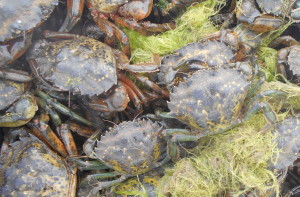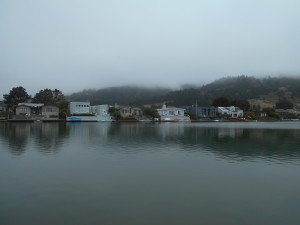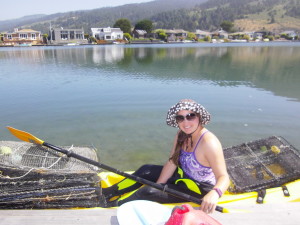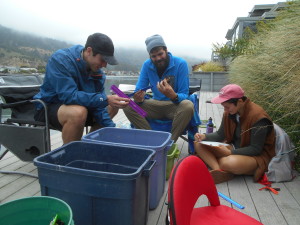Countin’ Crabs at Seadrift Lagoon
by Ryan Greene, science writing intern

European green crabs (Carcinus maenas) caught in Seadrift Lagoon (Stinson Beach, Calif.). Credit: Ryan Greene/SERC
The Smithsonian Environmental Research Center’s (SERC) largest west coast outpost, SERC-West, sits on San Francisco Bay in Tiburon, California. SERC’s main campus is 2,000+ miles away on the Chesapeake Bay in Maryland. In an attempt to bridge this distance, we’ve launched “Tidings From the Sunset Coast,” a summer series highlighting the work at SERC-West. Our most recent story was a spotlight of our summer interns. This post is about the invasive European green crabs in Seadrift Lagoon, just north of San Francisco. Enjoy!
How many crabs are in the lagoon? This question may sound like the middle-school carnival contest of how many jelly beans are in the jar. But for ecologists at SERC-West, it’s no guessing game—the health of an ecosystem hinges on the answer.

Seadrift Lagoon is about 20 miles north of San Francisco Bay, and it’s said to have the highest density of European green crabs on the West Coast. Credit: Ryan Greene/SERC
Since 2009, Smithsonian scientists have partnered with the University of California, Davis, and Portland State University to tackle a two-clawed problem in Seadrift Lagoon: Carcinus maenas, the invasive European green crab. Seadrift is a small subdivision surrounding an artificial lagoon that sits smack between the Pacific Ocean and Bolinas Lagoon at the northern tip of California’s Stinson Beach. In the early 1990s, green crabs began to take up residence here, and since then they’ve done their fair share of damage.
The primary problems with green crabs in Seadrift are that they’re hungry and there are scads of them. This lagoon houses the highest density of green crabs documented on the West Coast, and they eat a whole lot. In nearby sites, like Tomales Bay and Bodega Bay, green crabs have caused native bivalve populations to plummet, and in some cases they have edged out other native crabs. In Seadrift, the sheer number of green crabs suggests that the impact on the ecosystem may be similarly drastic. That’s why in 2009, scientists at SERC-West, UC Davis, and Portland State started working with community members and citizen science volunteers to remove the crabs from the lagoon.

SERC researcher Lina Ceballos uses a kayak to deploy and collect crab traps in Seadrift Lagoon. Credit: SERC
At first, they aimed to eradicate the crabs completely. There aren’t that many studies on how to eliminate marine species, and given the relatively manageable size of the lagoon and the preponderance of crabs, it seemed like an ideal place to see how much effort would be required to completely remove an aquatic invader. Things, though, didn’t quite go as planned.
After extensive trapping brought green crab numbers down from about 125,000 to less than 10,000 crabs in the first five years of the project, the population boomed to over 350,000 in 2014. This, it seems, was due to an ecological phenomenon called overcompensation. Normally, adult crabs cannibalize some of the juvenile crabs, which is a natural control on the population. However, since the scientists’ eradication attempts were removing many of the adult crabs from the lagoon, there were few checks on the juvenile crabs. This, they think, allowed for the huge resurgence in 2014.
Since then, SERC researchers and their collaborators have shifted their focus away from eradication. Instead, UC Davis ecologist Ted Grosholz has spearheaded an effort to study the overcompensation effect in Seadrift. So while the question of how to successfully eliminate species like the green crab remains unresolved, the researchers now have an opportunity to investigate a rare phenomenon that may pose problems for future invasive species removal programs. For now, their goal is simply to reduce the number of crabs in Seadrift while taking careful note of how the population changes over time. To do this, the researchers are setting out crab traps, and then working with citizen science volunteers to gather data on the green crabs living in the lagoon.
This is the sound of hundreds of European green crabs fidgeting in a bucket before being measured and marked. Credit: Ryan Greene/SERC
But how can they know how many crabs there are?
The answer is a technique called mark-recapture, which ecologists use to estimate populations of animals in the wild. Essentially, scientists and volunteers capture crabs and then mark them by clipping off two small spines on their shells. They also measure them, determine their sex, and note any abnormalities (e.g. missing claws, damaged abdomens, etc.). A week or two later, they come back and set out their traps again. This time, they keep track of how many of the new batch of crabs are marked. Based on the proportion of marked crabs, they can mathematically deduce the total population.
Citizen science volunteers measure green crabs caught in Seadrift Lagoon. Credit: Ryan Greene/SERC
After the scientists have jotted down all of their measurements, they take the recaptured crabs from the lagoon and donate them to a local farm, where they are composted. Given the nitrogen in their tissues and the calcium in their shells, they make for great fertilizer!
Even though the scientists won’t be able to remove all the green crabs from the lagoon, SERC ecologists and their collaborators hope that reducing the population will give the ecosystem a chance at recovery. They also hope that with a smaller batch of mature adults, fewer crab larvae will be able to drift to other sites along the coast. For now, they’re setting out traps, sitting on the dock, and marking and measuring crabs, one by one.

UC Davis lab assistant Ian Pritchard measures European Green Crabs with two volunteers. This summer, SERC researchers, collaborators, and volunteers have measured and marked thousands of European green crabs in Seadrift Lagoon near Stinson Beach, California. Credit: Ryan Greene/SERC
***
The Green Crab Project is always looking for volunteers, and there are opportunities to participate in August and September! If you’re interested in getting your hands dirty in the field, feel free to contact Alison Cawood at cawooda@si.edu.
Funding for this project has come from such sources as the National Science Foundation and the Pacific States Marine Fisheries Commission.

